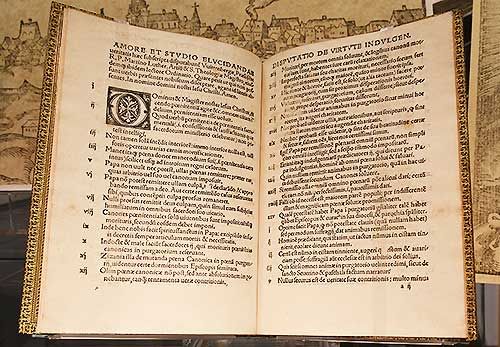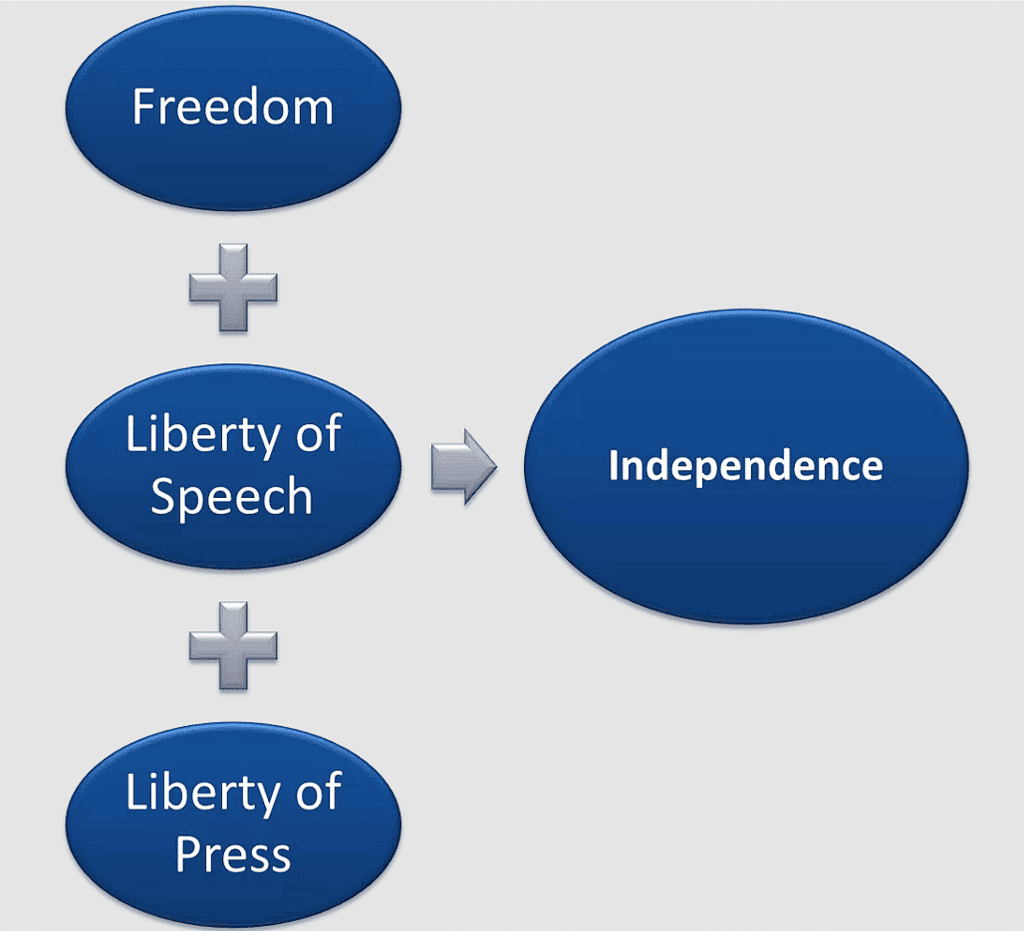NCERT Solutions for Class 10 History Chapter 5 - Print Culture and the Modern World
Q1: Give reasons for the following:
(a) Woodblock print only came to Europe after 1295.
Ans: The Italian explorer Marco Polo learned about woodblock printing during his visit to China. When he returned to Italy in 1295, he brought this knowledge with him, and gradually, it spread from Italy to other parts of Europe. Woodblock(b) Martin Luther was in favour of print and spoke out in praise of it.
Woodblock(b) Martin Luther was in favour of print and spoke out in praise of it.
Ans: In 1517, Martin Luther, a religious reformer, wrote ninety-five theses criticizing the corrupt practices of the Catholic Church and posted them on the door of a church in Wittenberg. The quick printing of thousands of copies helped spread his ideas widely, sparking the Reformation and leading to the rise of Protestantism. Luther was deeply impressed by how printing helped his ideas reach so many people.
 Ninety Five Theses(c) The Roman Catholic Church began keeping an Index of Prohibited Books from the mid-sixteenth century.
Ninety Five Theses(c) The Roman Catholic Church began keeping an Index of Prohibited Books from the mid-sixteenth century.
Ans: In the 16th century, print and popular literature helped people develop different interpretations of religious beliefs. Manocchio, a miller in Italy, found books easily available and came up with his own ideas about the Bible, God, and creation. His new views angered the Roman Catholic Church, leading to two trials and his execution during the Church's inquisition.
(d) Gandhi said the fight for Swaraj is a fight for the liberty of speech, liberty of the press, and freedom of association.
Ans: In 1922, during the Non-cooperation Movement (1920-22), Mahatma Gandhi stated that a nation needs freedom of speech, press, and association to thrive. He believed that these freedoms were essential for a country to free itself from foreign control.
 Formula of Indepence
Formula of Indepence
Q2: Write short notes to show what you know about:
(a) The Gutenberg Press
(b) Erasmus’s idea of the printed book
(c) The Vernacular Press Act
Ans:
(a) The Gutenberg Press
Johannes Gutenberg, from Strasbourg, invented the Gutenberg Press, the first printing press in Europe. Growing up on a large estate where he worked with olive and wine presses, he used this experience to create the printing press around 1448. The Bible was the first book printed using this groundbreaking technology.
(b) Erasmus’s idea of the printed book
Erasmus, the Latin scholar, was worried about the rise in book production due to printing. He feared that the widespread availability of books could spread rebellious ideas. Although he saw the value in some books, he was concerned that many might be irrelevant or illogical, leading to the spread of scandalous or irreligious ideas and potentially sparking rebellion.
(c) The Vernacular Press Act
In 1878, the British government in India passed the Vernacular Press Act, which gave them broad powers to censor reports and editorials in local language newspapers. If a newspaper published seditious content, it could be banned, and its printing equipment could be seized and destroyed.
 Vernacular Press
Vernacular Press
Q3: What did the spread of print culture in nineteenth-century India mean to:
(a) Women
(b) The poor
(c) Reformers
Ans:
(a) Women
As more women learned to read and write, they became important readers and writers. With better literacy, many women grew interested in reading and writing. Several journals highlighted the value of educating women, which led to magazines and books being made just for them. The rise of print culture gave women some freedom to read and form their own opinions on different topics, especially those related to women.
 Rashundari Devi
Rashundari Devi
(b) The poor
As literacy rates improved in both Europe and India, printed materials, especially for entertainment, became available to the poor. In England, "penny magazines" were sold by peddlers at low prices, making them affordable for even the poor. For those who couldn’t read, stories and folklore were shared aloud by others. Some book owners also rented out books for a small fee. In 19th-century Madras towns in India, very cheap small books became available, allowing the poor to take part in print culture.
(c) Reformers
Reformers used newspapers, journals, and books to highlight social issues in society. For example, Raja Ram Mohan Roy published 'Sambad Kaumudi' to raise awareness about the struggles of widows. From the 1860s onward, Bengali women writers like Kailashbashini Debi wrote books about women's experiences, focusing on issues such as being confined to their homes, kept ignorant, burdened with hard domestic work, and treated unfairly by the men they served.
Q4: Why did some people in eighteenth-century Europe think that print culture would bring enlightenment and end despotism?
Ans:
- Spreading of new ideas: After the coming of the print culture, the ideas of scientists and philosophers now became more accessible to the common people. Ancient and medieval scientific texts were compiled and published.
- Writings of scholars: The writings of thinkers such as Thomas Paine, Voltaire and Jean Jacques Rousseau were also widely printed, and could gain popularity. Thus, their ideas about science, reasoning and rationality found their way into popular literature.
- Books as a medium of progress: By the mid-18th century, books became a medium of spreading progress and enlightenment which could change society and the world. It was also believed that the books could literate society from despotism and tyranny.
- Ideas of enlightened thinkers: The print popularised the ideas of the enlightened thinkers like that of Martin Luther who attacked the authority of the Church and the despotic power of the state, e.g., Voltaire and Rousseau.
- A new culture of dialogue and debate: The print created a new culture of dialogue and debate and the public, became aware of reasoning and recognized the need to question the existing ideas and beliefs.
Q5. Why did some people fear the effect of easily available printed books? Choose one example from Europe and one from India.
Ans: The rise of printed books worried many, who feared they might spread rebellious or irreligious ideas and undermine traditional authority.
- Example from Europe:
Martin Luther's Ninety-Five Theses (1517) criticized the Catholic Church. Its rapid spread through print fueled the Protestant Reformation, disrupting Church authority. - Example from India:
In 19th-century India, conservatives opposed women’s education through print, fearing it would corrupt morals and challenge traditions. Despite this, many women pursued education.
Q6. What were the effects of the spread of print culture for poor people in nineteenth-century India?
Ans:
- The spread of print culture in 19th-century India significantly impacted the poor. Publishers produced cheap books sold at crossroads, and Christian missionaries and wealthy individuals established public libraries.
- Writings began addressing class discrimination. Jyotiba Phule, in Gulamgiri (1871), exposed caste injustices. Later, B.R. Ambedkar and Periyar wrote against untouchability and caste oppression, inspiring nationwide readers. Local movements also produced journals critiquing ancient scriptures, advocating for a just society.
- For poor workers, print offered a voice despite their struggles. Kanpur mill worker Keshibaba published Chhote Aur Bade Ka Sawal (1938), linking caste and class issues, while Sudarshan Chakra’s poetry highlighted workers’ experiences. By the 1930s, mill workers in cities like Bangalore and Bombay (Mumbai) established libraries to educate themselves, supported by reformers promoting literacy, sobriety, and nationalism.
Q7. Explain how print culture assisted the growth of nationalism in India.
Ans:
- New ideas and debates: Many people criticized existing practices and campaigned for reforms, while others challenged the reformers' arguments. These debates happened openly in public and through print.
- Connecting various communities: Print not only encouraged the spread of differing opinions among communities but also connected people across different parts of India. Newspapers transmitted news from one region to another, helping to build a sense of pan-Indian identity.
- Print and newspaper: Despite efforts to suppress them, nationalist newspapers increased across India. These newspapers reported on colonial misrule and promoted nationalist activities.
- Various novels on national history: Indian novelists wrote many works that helped create a sense of pan-Indian identity. For example, Bankim Chandra Chatterjee’s Anandamath fostered a feeling of unity across India. Munshi Premchand’s Godan illustrated the exploitation of Indian peasants by colonial officials.
- Various images of Bharatmata: Printers like Raja Ravi Verma and Rabindranath Tagore created images of Bharatmata (Mother India) that inspired a sense of nationalism among Indians.
|
66 videos|630 docs|79 tests
|
FAQs on NCERT Solutions for Class 10 History Chapter 5 - Print Culture and the Modern World
| 1. What is the significance of print culture in the modern world? |  |
| 2. How did the invention of the printing press impact society? |  |
| 3. What role did print culture play in the Indian independence movement? |  |
| 4. In what ways did print culture contribute to the rise of the middle class? |  |
| 5. How did technology influence print culture in the modern world? |  |






















